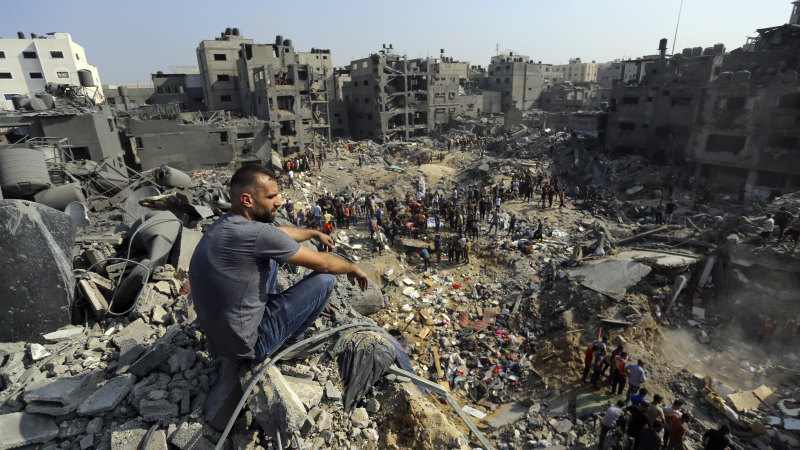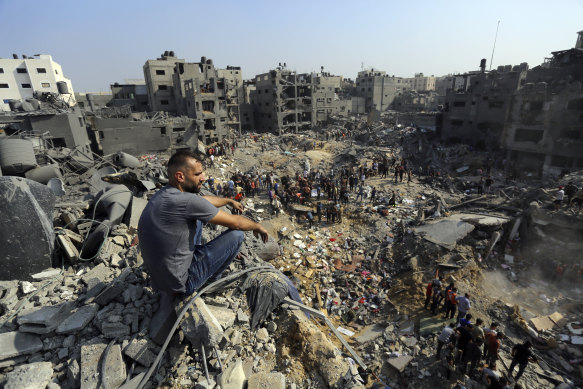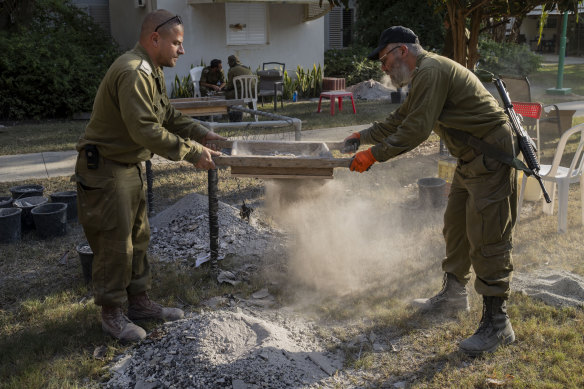Save articles for later
Add articles to your saved list and come back to them any time.
Gaza/Jerusalem: Israel has agreed to pause operations in northern Gaza for four hours a day from Thursday, the White House said, in the first sign of a respite in more than a month of fighting that has left thousands dead and stoked fears of a regional conflict.
The pauses would allow people to flee along two humanitarian corridors and were significant first steps, White House national security spokesperson John Kirby said.
A man sits on the rubble overlooking the debris of buildings that were targeted by Israeli airstrikes in the Jabaliya refugee camp, northern Gaza Strip.Credit: AP
“We’ve been told by the Israelis that there will be no military operations in these areas over the duration of the pause, and that this process is starting today,” Kirby said.
The pauses, which would be announced three hours in advance, emerged out of discussions between US and Israeli officials in recent days, including talks US President Joe Biden had with Israeli Prime Minister Benjamin Netanyahu, Kirby added.
Earlier, Israeli forces fought Hamas militants among ruined buildings in the north of the Gaza Strip, inching their way closer to two big hospitals as the plight of civilians in the besieged Palestinian territory worsened.
Thousands more Palestinians were fleeing from the embattled north to the south along a perilous frontline path littered with bodies after Israel told them to evacuate, people on the route said.
But many are staying in the north, packed into the Al Shifa Hospital and al-Quds Hospital as ground battles rage around them and more Israeli air strikes rain down from above.
Israel says its Hamas foes have command centres embedded in the hospitals.
In Doha, the heads of the CIA and Israel’s Mossad intelligence agency met with the prime minister of Qatar to discuss a possible deal over hostages, a US official said, speaking on condition of anonymity. Qatar has served as a mediator with Hamas in the past.
In Paris, officials from about 80 countries and organisations were meeting to coordinate humanitarian aid to Gaza and find ways to help wounded civilians escape the siege, now in its second month.
“Without a ceasefire, lifting of siege and indiscriminate bombarding and warfare, the haemorrhage of human lives will continue,” Jan Egeland, Secretary General of the Norwegian Refugee Council, said before the White House announcement.
Israel and its main backer the United States say a full ceasefire would benefit Hamas.
Israel unleashed its assault on Gaza in response to a cross-border Hamas raid on southern Israel on October 7 in which gunmen killed 1400 people, mostly civilians, and took about 240 hostages, according to Israeli tallies.
It was the single worst day of bloodshed in Israel’s 75-year history and drew international condemnation of Hamas and sympathy and support for Israel.
IDF soldiers trying to find items that will help identify people killed at Kibbutz Nir Oz, Israel, near the Gaza Strip.Credit: AP
But Israel’s retaliation in the Hamas-ruled enclave has caused great concern as a humanitarian catastrophe has unfolded.
Palestinian officials said 10,812 Gaza residents had been killed as of Thursday, about 40 per cent of them children, in air and artillery strikes while basic supplies are running out and areas laid waste by unrelenting Israeli bombardments.
Residents in Gaza City, a Hamas stronghold, said Israeli tanks were stationed around the area. Both sides reported inflicting heavy casualties on one another in intense street battles.
Israel, which has vowed to wipe out Hamas, says 33 of its soldiers have been killed in its ground operation as they advanced into the heart of Gaza City.
Nowhere to run to
Thousands of Palestinians have sought refuge at Al Shifa hospital inside Gaza City despite Israel’s orders to evacuate the area it has encircled. They are sheltering in tents in the hospital grounds and say they have nowhere else to go.
The UN humanitarian office OCHA said Israeli had again told residents of the north to move south, and that shelling around the main road continued, endangering evacuees.
“We saw decomposed bodies, people from civilian cars, civilians like us, not military cars or resistance men,” Khaled Abu Issa said after crossing into the south with his family at Wadi Gaza.
Another resident, who asked not to be named, said he had crossed with his wife and six children.
“You have to hold your ID card in your hand and raise it as you go past the Israeli tanks and then walk several more kilometres searching for a lift,” he said.
Southern areas have also come under regular attack. In Khan Younis, Gaza’s main southern city, residents picked through the rubble and debris of a building destroyed by an Israeli air strike, hoping to find survivors, on Thursday morning, witnesses said.
Tensions have also soared on other fault lines. Lebanese Islamist group Hezbollah said it fired missiles over the border into Israel, and Israel’s military said it responded with artillery fire.
Ten Palestinians were killed by Israeli forces in a raid on Jenin city and refugee camp in the occupied West Bank, the Palestinian health ministry said. Israel’s military said it was conducting counter-terrorism raids.
An unidentified drone hit a civilian building in the southern Israeli port city of Eilat, the Israeli military said, causing only light damage.
Reuters
More coverage of the Hamas-Israel conflict
- Cascading violence: Tremors from the Hamas attacks and Israel’s response have reached far beyond the border. But what would all-out war in the Middle East look like?
- The human cost: Hamas’ massacre in Israel has traumatised – and hardened – survivors. And in Gaza, neighbourhoods have become ghost cities.
- “Hamas metro”: Inside the labyrinthine network of underground tunnels, which the Palestinian militant group has commanded beneath war-ravaged Gaza for 16 years. The covert corridors have long provided essential channels for the movement of weapons and armed combatants.
- What is Hezbollah?: As fears of the conflict expanding beyond Israel and Hamas steadily rise, all eyes are on the militant group and political party that controls southern Lebanon and has been designated internationally as a terrorist group. How did it form and what does Iran have to do with it?
Get a note directly from our foreign correspondents on what’s making headlines around the world. Sign up for our weekly What in the World newsletter.
Most Viewed in World
From our partners
Source: Read Full Article


